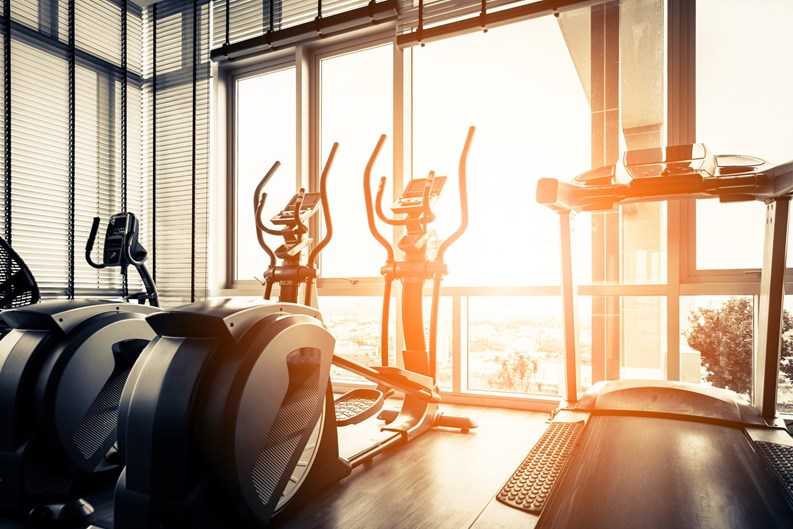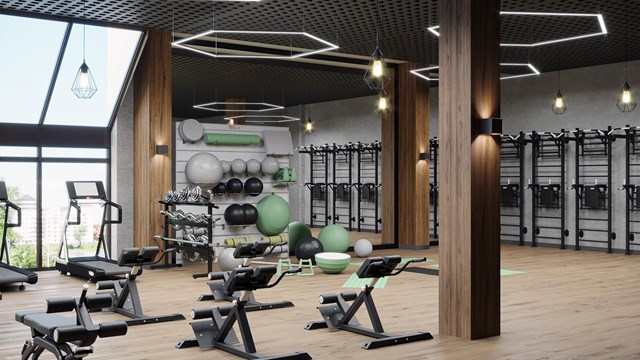By far the most popular amenity in apartment communities, whether co-op, condo, or rental, is a gym. Even in small buildings where space for extras is at a premium, boards look for ways to add a fitness room somewhere, anywhere, they can wedge it in. But what makes a gym or fitness room as well-used and efficient as it can be? That formula may be less complicated – and less space-dependent – than you think.
The Cutting Edge in Gyms
Gail Hamilton, executive director at ProFIT, a national fitness space management firm based in New York City, says technology is the dominant theme in gym design and management today. “The trend is toward computerized metrics with other exercisers,” says Hamilton, citing the popular Peloton bike as an example of equipment that lets the rider pit themselves against other users and an online instructor. Other amenities, like being able to stream video or go online to check email while you work out are not going away. Today’s users have grown up with technology, and they need and use it while exercising. Interactive technology makes regular TV in a gym obsolete; today’s users want live stream, without the hassle of channel flipping – and they want it with a live feed showing how many calories they’re burning in real time. “Basically,” says Hamilton, “they want what they want when they want it, and that’s what we try to give them.”
Media aside, Hamilton continues, “Cardio is still king” when it comes to what most users look for in a gym. That means lots of treadmills, bicycles, and newer devices like the Mirror, an unobtrusive flat-screen display that can connect users to an array of streaming, instructor-led classes in everything from yoga to kickboxing. And while Hamilton says that Peloton no longer sells its product to multifamily buildings (likely because doing so could cut into their individual unit sales), Peloton’s main competitor, Echelon, will. The Mirror also doesn’t restrict multifamily sales to multifamily buildings – and Hamilton reports that they are putting this kind of equipment in middle-market buildings as well as high-end properties.
In terms of design, Hamilton advises boards and residents to think big. Provide more space than you think will be sufficient – because it never is sufficient. Don’t go cheap on equipment either. “You are designing the space for 10 years from now,” she says. “Not just for today. The more you spend up front, the longer it will last, requiring fewer upgrades later.”
In terms of strength training equipment, single-exercise, ‘isolation’ devices such as leg extension machines are decidedly passe; not only do they take up too much space, but as fitness consumers have become better informed and sophisticated about their programming, they’re demanding equipment that supports a more holistic, integrated approach to training. The current trend is toward more multifunctional products like Gravitron, or the Queenax, a modular system that incorporates multiple, functional exercises into a sleek, space-conscious design with storage areas for exercise components and attachments within it.
Another consideration to take into account when planning a fitness space is that more and more users are opting to bring personal trainers into their building’s in-house fitness rooms, rather than brave the crowds and hassle of a commercial gym. A coach or trainer may not take up as much space as a clunky weight machine, but they do need room to work with their clients safely and effectively – so it’s important to account for those possible extra bodies moving around the space, particularly during peak training times in the early morning and evening.
Speaking of Trainers...
There are plenty of companies that specialize in designing, building out, and in some cases staffing and managing in-house gyms in residential buildings, but if you’re in a smaller building with more limited space and budget, a more economical alternative to hiring a professional gym design firm might be to consult a seasoned personal trainer with experience working in residential gyms. Not only are they familiar with the unique challenges of such spaces, but they may be able to help you avoid design or layout blunders that will make your gym space less functional and safe.
Rachel Lavin has been training clients in their in-building gyms in New York for more than 20 years. “The problem with these gyms,” she says, “is that they are often designed by the board to fit the space” – and the space is inevitably too small. “Not to be rude,” Lavin continues, “but they don’t have a clue what to do. Boards should always consider more space than they originally intend to provide, and they should have a professional design it.”
Like Hamilton, Lavin advises boards to keep away from old, clunky, single-exercise equipment. It’s inefficient, takes up too much space, and can be replaced with better options. And, she continues, gyms nearly always try to cram in too much cardio equipment, crowding out other options that would be better used. For example, she says, a full set of free weight dumbbells and kettlebells are much more important and flexible for most users than a rowing machine or stationary bike. “I want my clients to be ‘life functional,’ says Lavin, “so more types of exercise than just cardio are necessary.”
David Orsini, another New York-based personal trainer with many in-house gym clients echoes Lavin’s critique of rooms overloaded with cardio equipment and adds that, “Particularly as people age, they have an increased fall risk. Strength training is what they need to minimize that risk. It helps them maintain body balance and equilibrium; cardio exercise doesn’t do that.”
To be sure, cardiovascular exercise is beneficial for nearly everyone, and does have its place in an exercise regimen – but as Orsini points out, “Today’s clients are seeking a certain physical look. They want to be trim and cut. They want to look like they work out. If you do 30 minutes of cardio you will lose fat, but it doesn’t build muscle or affect the look of the body.” For that, you need resistance work – weight training, in other words.
So to recap: both Lavin and Orsini recommend that when designing or redesigning an in-building gym, your board should consider increasing the size of the gym itself, editing down the cardio equipment to a couple of key pieces, and including dumbbells, kettlebells, and most importantly, a multifunctional, multi-exercise cable-pulley tower system for resistance training. If there’s sufficient room, a squat rack is a nice addition, too.
Exercise today is more than a squeaky treadmill and an Olivia Newton-John aerobics video. Boards need to consider professional expertise when designing their fitness spaces, the same way they would consider professional advice in any other major building project or decision. Doing so will result in an amenity that’s not just well used and well loved, but that adds real value to your building as well.
A.J. Sidransky is a staff writer/reporter for The New Jersey Cooperator, and a published novelist.







Leave a Comment